By Carol Woodbridge Mulder © 1990
** Originally published in the November December 1990 issue of The Crabbet Influence magazine. Also published in The Crabbet Influence's 1993 Collector's Volume II.
*Malouma 738 and *King John 739 had been brought to the Kellogg Ranch to be boarded in September of 1930 by their owner, Herman W. Frank of Los Angeles, California. In March of 1931 W. K. Kellogg bought the pair of Egyptian imports. They were the only Egyptian Arabians ever used in the old Kellogg breeding program.
*Malouma 738
Age 6. Gray mare foaled October 28, 1924. Kehilan Nauwak. Bred by El Hag Mahmoud Matlak, Cairo, Egypt. Sire: Maloum, by Warid Min El Arabian (Wad Min El Ebb - desert bred) out of Bint Sheha (Ibn Mendooh - Sheha). Dam: Sheha, by Abu Sheha Gadeem (desert bred - desert bred) out of Bint Ibn Mendooh (Ibn Mendooh - desert bred). Sire line: Wad Min El Ebb. Family: Bint Ibn Mendooh. (*Malouma is shown at the top of page, in 1945 at age 20. With her last foal, the bay colt Bariz 3290, by Farana 708.)
*King John 739
Age 8. Gray stallion foaled May 23, 1922. Seglawi Jedran. Bred by El Hag Mahmoud Matlak, Cairo, Egypt. Sire: Desert bred. Dam: Desert bred. Sire line: *King John 739. Family: Desert bred.
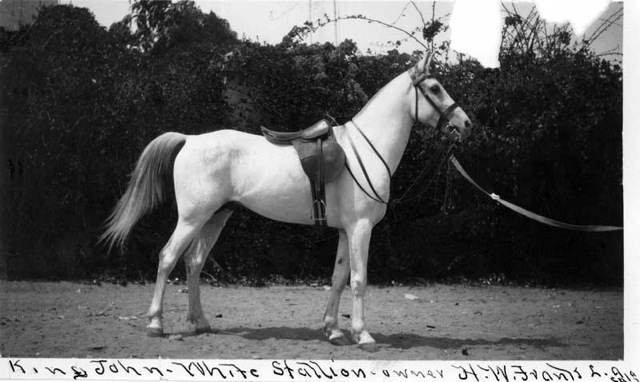
Both of these beautiful animals were destined to become important to the Kellogg Ranch, but for different reasons. *Malouma became a treasured and very successful broodmare while *King John found his role as a star attraction in the famed Sunday afternoon exhibitions.
Mr. Frank, one of the founders of the Harris and Frank Company in Los Angeles, purchased *Malouma and *King John in Egypt in March of 1929. He had seen them as a Cairo race meet. Several months after Frank left Egypt, the horses were shipped from Alexandria, Egypt, on September 15, 1929, landing in New York seventeen days later on October 2nd. They traveled by rail with a groom to California, arriving at Los Angeles in November. Mr. Frank at first quartered them at his Riverside, California ranch and later at Los Angeles where *King John was Reserve Champion Arabian Stallion at the Los Angeles National Horse Show in 1930 and also won first prize in the ridden class for Arabs. At this same show, *Malouma was named Reserve Champion Arabian Mare.
The background of *King John is of interest. While evidently bred in Cairo, both parents were of desert stock. In 1927, at age 5, he was purchased by Colonel H. Milward, apparently of the British 12th Royal Lancers. In May of that year *King John was classified under the name Assaf by the committee appointed by the Jockey Club of Egypt. He was trained as a polo pony at which work he excelled. He played in all the tournaments in Cairo until the spring of 1928 when he was sold to Captain R.I. Hadden, an Englishman who was one of the proprietors of The British Saddlery and Sports Company in Cairo. Captain Hadden put *King John into training for flat racing.
*King John ran his first race - under the name Assaf - at Alexandria on April 9, 1928. It was 5 furlongs and he won by 5 lengths in the fastest time ever done by an Arab in Egypt up to that time. He continued running for Captain Hadden until Mr. Frank bought him and thereafter he ran under Franks name and Hadden's management. He continued to do well with a few more wins. By the end of his Egyptian racing career he was being handicapped. During one of his 1929 races he ran 1 ⅜ miles in 2:34 carrying 107 pounds. This set a record for Arabians, said then to have been the fastest time ever run by and Arab in Egypt.
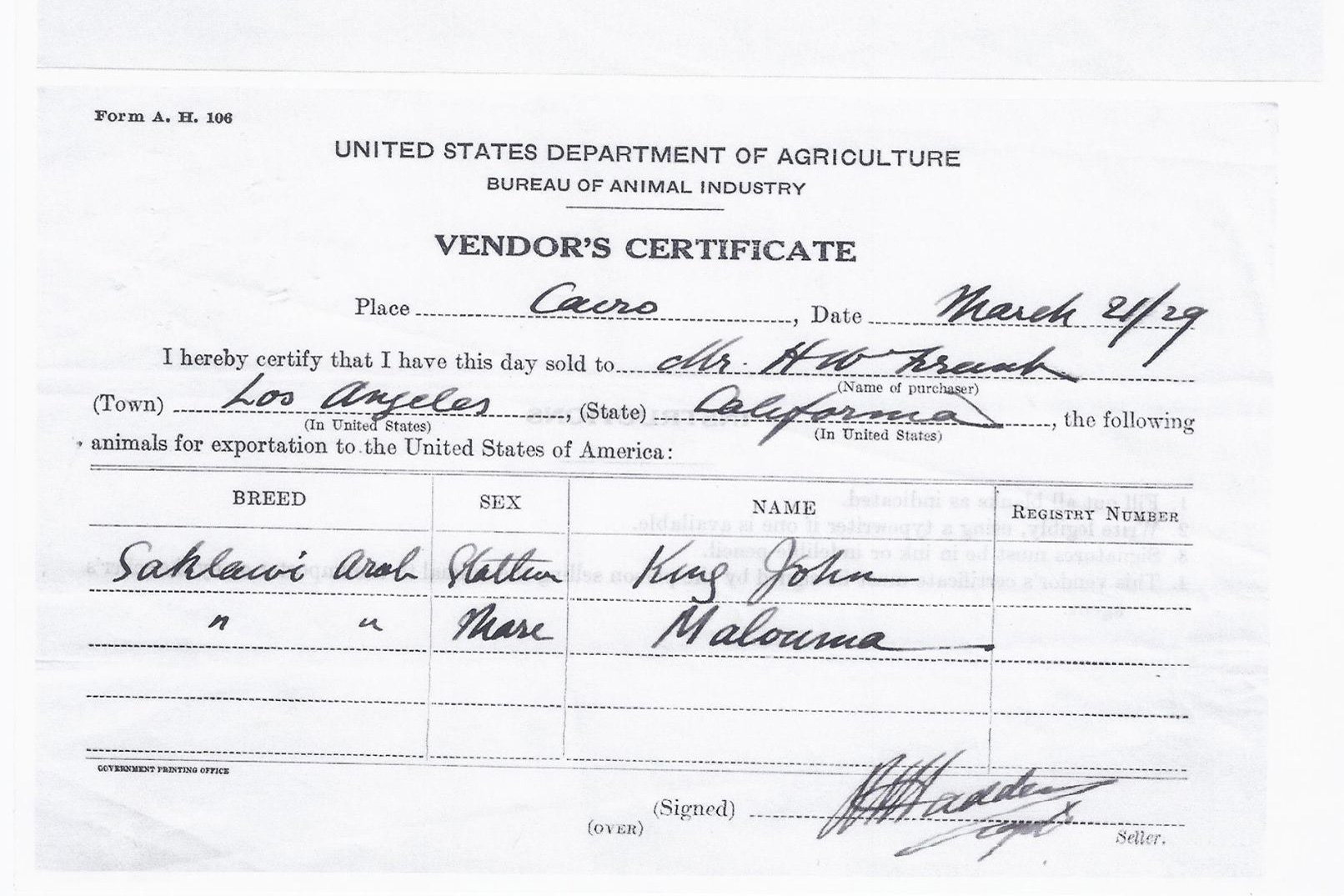
*Malouma, bred by the same man who bred *King John, was of the esteemed Egyptian Tahawi stock which soon ran back into desert lines. Captain Hadden was able to obtain *Malouma for Mr. Frank because her joint owners were having a dispute.
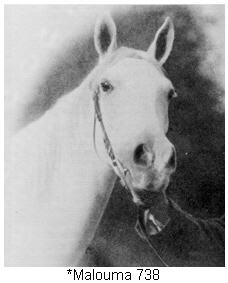
Prior to her purchase by Mr. Frank, *Malouma had won one race. Under Frank's ownership she ran, in July 1929, in a 7 furlong race; she ran well, but dropped back the last few strides to fourth place. It was felt that 7 furlongs was too much distance for her.
Before *Malouma left Egypt, the manager of the stud of King Ahmed Fuad tried to buy her for the King's private breeding program and the manager of the Royal Agricultural Society said that he did not feel a mare of *Malouma's quality should be allowed to leave the country.
At the Kellogg Ranch *King John became a favorite with the large audiences which came to the Sunday afternoon exhibitions. He was at first shown as a three-gaited horse by Charles A. Smith. His clear snow white color and his magnificent, breath-taking, airy trot - all entirely natural - made him unforgettable.
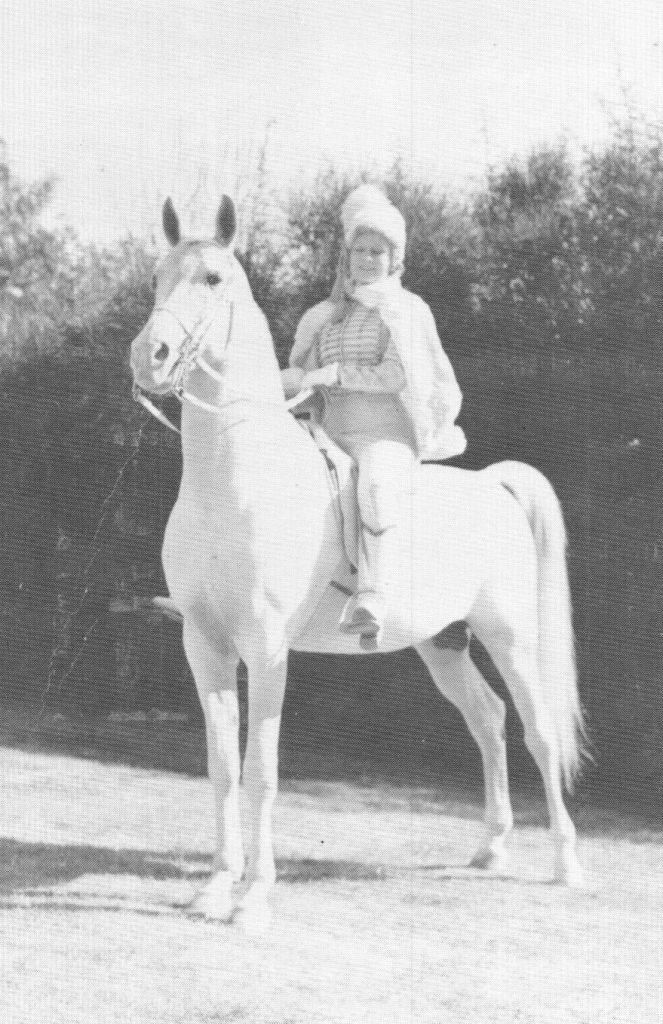
*King John appeared in several Hollywood movie productions. He was ridden by the famous actress Marlene Dietrich in The Scarlett Empress. He was used in the Gary Cooper film Lives of a Bengal Lancer and was featured in The Garden of Allah. Walt Disney artists used *King John as the model for the white stallion ridden by the prince in Snow White and the Seven Dwarves.
After *King John's appearance in The Scarlett Empress, the Kellogg Ranch acquired the striking military-style white, trimmed with gold, costume which Marlene Dietrich had worn when riding him in the film. Thereafter he was shown in the Kellogg exhibitions by Stella Smith who was attired in that costume. *King John still performed three-gaited, still with his awesome trot, but he made an even more riveting impression than he had with Charles Smith because of the all white and gold picture he and Stella presented with the snappy white costume, the white saddle and bridle, and the pretty little woman riding with her blonde curls matching the gold trim of the costume.
In 1936 *King John spent six months on exhibition with other Kellogg Arabians at the Days of Saladin exhibition in connection with the World's Fair at San Diego, California. One June 5, 1940, he received a special note of appreciation from the City of Redlands, California, for his outstanding participation in the De Anza Days Parade held in May of that year when he was 18 years old.
At the age of 24 *King John stood 14.2 hands, had 7 inch bone (measured correctly midway between knee and fetlock joint), and weighed 812 pounds. During all his time at the Kellogg Ranch - even well into his old age - he exhibited a proud, stylish carriage and caught the eyes of all who saw him. He had a look of elegance. He also had a wonderful disposition. Captain Hadden aptly described him as ".....very fine character.....friendly, good tempered and well mannered......" These remarks fit *King John well. At the Kellogg Ranch he was considered one of the most easily handled and agreeable of all the stallions.
*King John was one of the few Arabians who truly 'floated' at the trot in a correct manner at the highest phase of flexion. Most of the trots erroneously described as 'floating' are, in fact, displaying the very serious and distressing motion aberration of dwelling which is the result of a short front stride and lack of proper synchronization. *King John's true and correct float was quite different and wonderfully beautiful to watch because he seemed to be almost airborne in a delicate and light manner displaying extreme Arab style; the impression was nearly ethereal. His trot was amazingly graceful and airy. He had high lift and flexion of his knees and hocks, drive from behind, and impressive reach with resulting good length of stride and proper synchronization.
Although he was, without question, a stunningly beautiful horse, particularly when trotting, *King John was like all horses and had some faults. His head was somewhat long without having compensating assets to offset the length. His ears were lopped and larger than is desirable. He had a narrow frame, but, since many desert horses of that time exhibited this trait and did not seem to pass it on, it can be assumed that he may have been raised in harsh circumstances which caused the narrowness. From the side view he was quite crooked in the hocks.
Despite his many good traits, his magnificent trot, and his running speed, *King John's flaws caused him to be used only once at stud at the Kellogg Ranch; he was living in the shadow of stallions with much typier heads and ears and better hind legs.
In late March of 1931 he was bred to Babe Azab 567 and on March 5, 1932, his only purebred foal, his gray son Janeo 915, was foaled. Janeo, in his turn, sired only one foal, the mare Reshan Azab 7228, foaled in 1951 when he was 19. Through this connection *King John does have several living descendants today, many existing because of the race breeding program of Austin and Hazel Lucas in Nevada. Some very successful American runners have carried *King John blood. Mr. and Mrs. Lucas also did some multiple breeding back to *King John.
It is probably unfortunate that the Kellogg Ranch did not try *King John with other mares and that no further attempt was made to enable him to breed on his many good qualities. When I was a teenager I once saw a truly beautiful and classic half-Arabian mare sired by *King John; like her sire, she was a clear snow-white shade of gray. I do not know what sort of dam this half-Arabian *King John daughter had, but she did indicate that he probably had capability to sire quality stock with some mares.
At the Kellogg Ranch *Malouma became a premier broodmare, although at first some attempt was also made to use her for riding. My father, Dudley B. Woodbridge, told me that he tried riding her twice, but he did not want to ride her again because she was 'gimpy' in front - was sore in front - and as a result was sour about being ridden. Few people enjoy riding a hurting horse and so *Malouma was not asked to be a saddle mare. Apparently she had been damaged on the track in Egypt, although her front legs showed no injuries. Except for the sourness under saddle, *Malouma was otherwise a very amiable and agreeable mare who had a kindly attitude to both people and other horses.
*Malouma was a beautiful, typy, and feminine mare. Her head was lovely, although her ears could have been better. She was also criticized for a rather short neck and exaggerated spring of rib, but her neck was pleasing in appearance. Overall, her conformation was exceptionally good. Her back was short and her coupling smooth, strong, and short. Her legs were good from the side view and from the front and rear views they showed only minor misalignment which was probably environmentally caused; she did not pass on these minor flaws. *Malouma was also a white/gray, although not as totally clear white as *King John. She stood 14.2 hands, her bone measured 7 ½ inches, and she weighed 950 pounds.
As a broodmare *Malouma proved capable of producing quality stock by any stallion to which she was bred. She gave birth to a total of eleven foals between the years 1932 and 1945; there were six fillies and five colts. Among her daughters were such illustrious mares as the lovely, classic 1934 gray Rasoulma 1052, 1935 Ralouma 1132 (both by *Raseyn 597), the superior quality 1942 bay Farlouma 2345, and 1944 bay Pomona Avesta (both by Farana 708). *Malouma's 1937 gray daughter Lourana 1441 (by Farana) was exported to Columbia in South America. Her 1938 gray son Malkin 1493 (by Sikin 964) was a well-regarded horse of his time.
While I cannot remember details for certain, I do remember that one year *Malouma took and 'adopted' an orphaned foal who was younger than her own; she took care of both foals, of disparate sizes, with equal attention and devotion; she had that kind of temperament.
As he aged, *King John developed many melanomas. The largest was under his tail and when it attained a size which prevented normal functions he was humanely put down on September 25, 1946. He was 24 years old. He was certainly one of the most beloved horses at the Kellogg Ranch and his loss was felt keenly; he was a friend to all. He had done much over his life to win many converts to the beauty of Arabian horses and an appreciation of their temperaments which so ideally suit them for many different tasks; *King John had been one of the most versatile of horses by his own example. It is seldom that one finds an individual with his excelling capabilities in so many different fields - he had been an accomplished polo pony, a record-setting winning race horse, a breathtaking three-gaited horse, a movie horse, and a parade horse. He was a true athlete and proved, with considerable educational impact, along with many others before and since, that Arabians with exceptional action at the trot (high knee and hock flexion with long reach and stride) are capable of meaningful success in other athletic endeavors requiring exceptional talent.
*Malouma died May 24, 1948, at the age of 23 years.
By 1931 it was clear to Mr. Kellogg and his manager, Herbert H. Reese, that the large number of visitors to the ranch and the high attendance at the Sunday exhibitions warranted the construction of a formal show ring with bleacher seating. Accordingly a fine facility was added. The outdoor show ring was large enough to accommodate an eight-horse Percheron hitch with large show 'brewery' wagon running full-tilt and doing all sorts of intricate turns and maneuvers. In the center was a small cement curbed ring for certain types of in-hand and/or trick exhibitions. Bleachers on the west side were roofed while those on the east side were under an arbor covered with climbing roses. The ring fence was painted white. It all formed a most attractive backdrop for the beautiful Arabian horses exhibited there during the next more than 30 years.
In October of 1931 Mark Smith was hired as a Kellogg trainer. He had formerly been with the Barnes Circus. Mark was not related to Kellogg trainer Charles A. Smith. It was Mark's wife, Stella, who rode *King John in the Kellogg shows. The oldest Smith son, Harold, drove a miniature Roman chariot, drawn by four little Shetland ponies, in the Kellogg exhibitions. Richard, the youngest Smith son, took part in the filming of the famous movie Gone With The Wind. There is a scene in the movie where a little girl falls off of a black pony when the pony goes over a hurdle. Young Richard Smith, well trained from babyhood to perform many circus type stunts on horseback, was the child double for the female child actress who played the little girl in the film. Richard had to dress up as the little girl and fall off the pony. He did it successfully and when one sees the film it is not possible to notice that the little girl falling off the pony was Richard and not the little girl actress.
The Mark Smith family had their own favorite black Shetland pony which they brought with them when they came to the Kellogg Ranch. His name was Coaly. I wonder if Coaly may have been the black pony used in Gone With The Wind. While I do not remember riding Coaly, Mark used to tell me that Coaly was the first equine I ever rode when I was a very tiny toddler.
One of the first things Mark did when he arrived at the Kellogg Ranch was to begin training a liberty drill such as one sees in circuses. In the amazing short time of only two weeks he had eight young Arabians ready to make their debut in the Sunday afternoon Kellogg exhibitions in the new show ring. These horses were exhibited in bitting-rig type of harness with large letters attached to the surcingles; when the horses lined up in proper order the letters spelled KELLOGGS. On signals from Mark, they moved around the ring singly, doubly, in fours, or in eight across formation, they mixed themselves up and then unscrambled themselves, they lined up and put their necks across the backs of their neighbors slightly in front in a unison formation, they walked the cement curb of the inner ring with their front feet, and as a finale they all reared. The audiences loved this sort of exhibition. The first liberty drill consisted of all chestnuts. Over the succeeding years the liberty drills were sometimes made up of all bays. While usually all of one sex, the magnificent stallion Rifnas 924 once led a drill composed otherwise of all mares and/or fillies. Usually the Kellogg liberty drills were all young animals; the liberty drill training seemed to be something given some of the Kellogg stock during the period before they had finished their career riding or driving training. In later years the liberty drills were usually made up of all colts of 2 and 3 years.
Mark Smith was also the trainer of the great Farana, whose story appeared in Part 11 of this series.
**All of the articles included in the re-launched Crabbet.com site from the original website, Georgia Cheer, Silver Monarch Publishing and The Crabbet Influence magazine are shared here with permission of Georgia Cheer given May 16, 2012.**

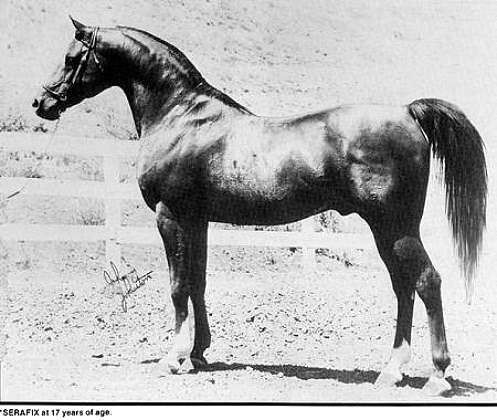

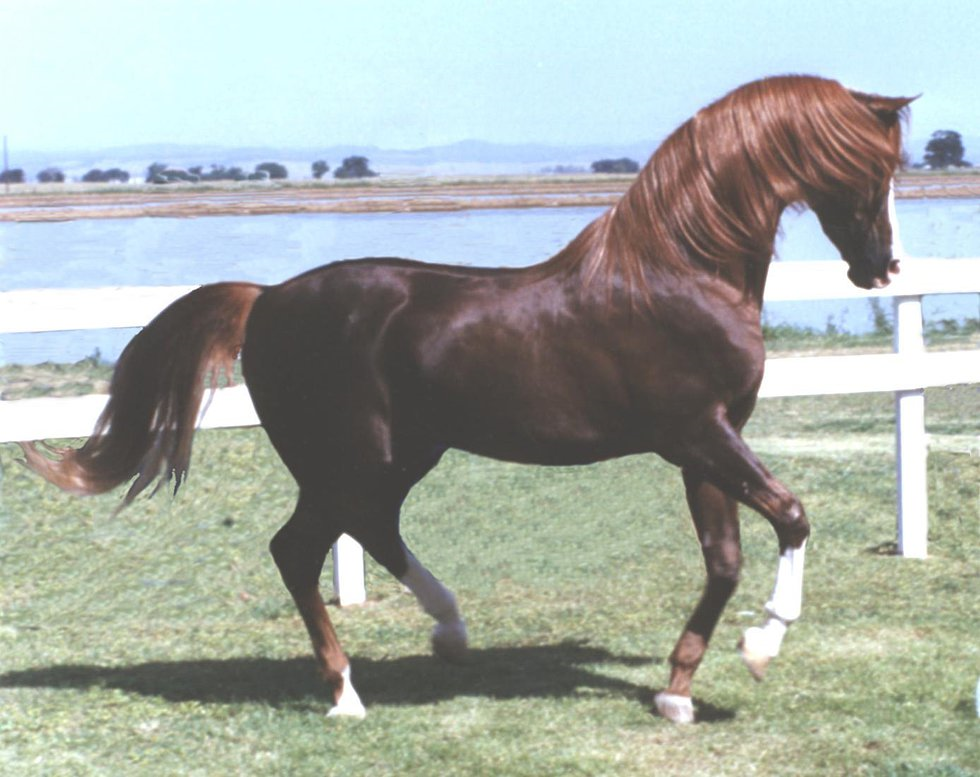
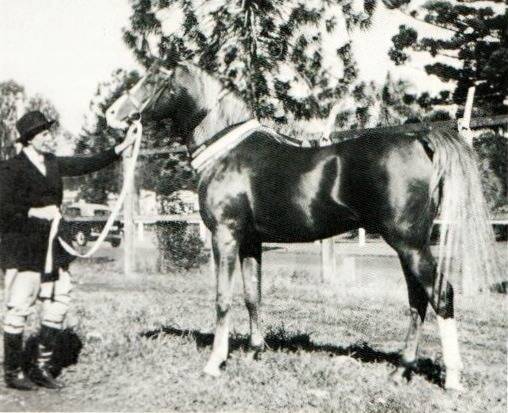
Comments
No Comments